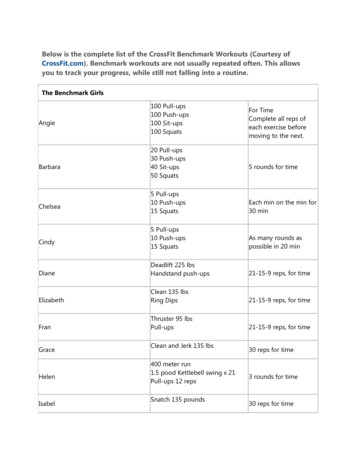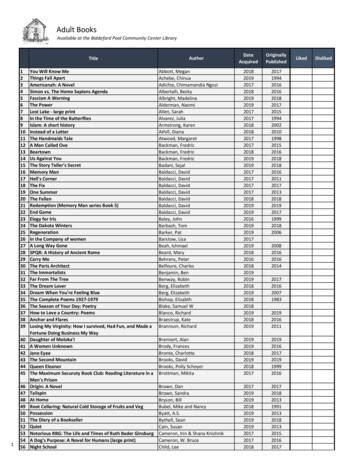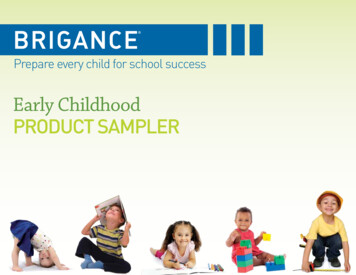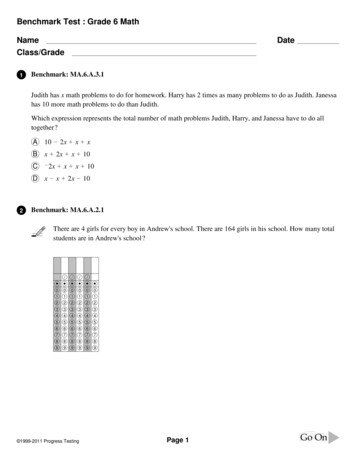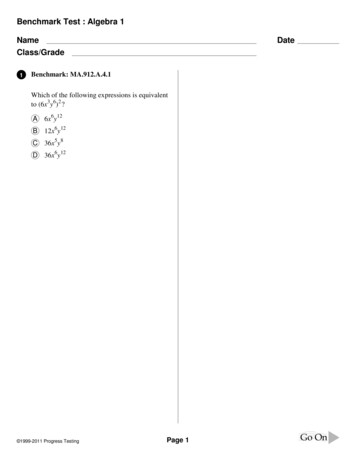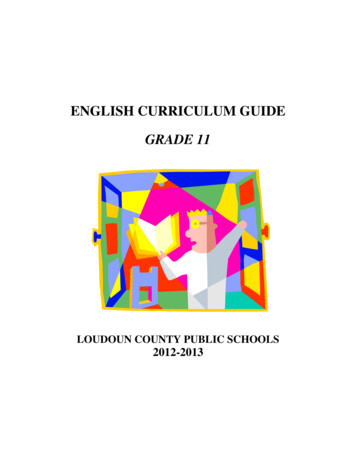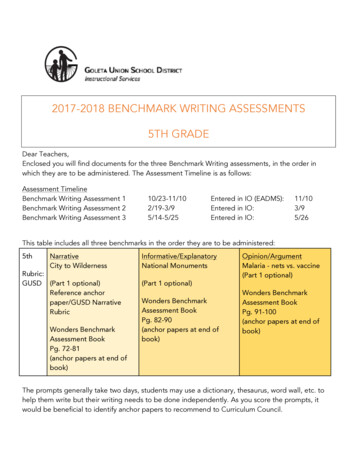
Transcription
2017-2018 BENCHMARK WRITING ASSESSMENTS5TH GRADEDear Teachers,Enclosed you will find documents for the three Benchmark Writing assessments, in the order inwhich they are to be administered. The Assessment Timeline is as follows:Assessment TimelineBenchmark Writing Assessment 1Benchmark Writing Assessment 2Benchmark Writing Assessment 310/23-11/102/19-3/95/14-5/25Entered in IO (EADMS):Entered in IO:Entered in IO:11/103/95/26This table includes all three benchmarks in the order they are to be administered:5thNarrativeCity to WildernessRubric:GUSD (Part 1 optional)Reference anchorpaper/GUSD NarrativeRubricWonders BenchmarkAssessment BookPg. 72-81(anchor papers at end ofbook)Informative/ExplanatoryNational Monuments(Part 1 optional)Wonders BenchmarkAssessment BookPg. 82-90(anchor papers at end ofbook)Opinion/ArgumentMalaria - nets vs. vaccine(Part 1 optional)Wonders BenchmarkAssessment BookPg. 91-100(anchor papers at end ofbook)GUSDThe prompts generally take two days, students may use a dictionary, thesaurus, word wall, etc. tohelp them write but their writing needs to be done independently. As you score the prompts, itwould be beneficial to identify anchor papers to recommend to Curriculum Council.
ScoringPlease input the scores into IO by the deadlines noted above. If you need assistance,please contact me. Access the input area under Input/Edit Scores (not Responses),either from the top menu or from one of the tiles on your Home page.Collaborative scoring provides a measure of calibration and ensures teachers are usingthe rubric in the same way. Using the rubric, grade level colleagues independently andsilently read the student work to result in two scores for each student paper.Record the numerical scores for each student for the four or five areas on the rubric.The scoring rubric and evidence in the student work should always be the basis for thescore, rather than the relative strength or weakness of a piece.Once two scores have been determined, average the two for a final score in the four orfive categories according to the rubric and enter them into IO. Please note IO will nottake a decimal score, the final score must be a whole number. If a student receives a 2and 3 for a category, the average is 3, not 2.5. Round up!If you need assistance with scores input or have any questions, please contact me.Thank you,Liz
GUSD – Narrative Rubric, Grade 5PurposeCCSS*:Ø W – 3aØ W–4OrganizationCCSS:Ø W – 3aØ W – 3cØ W – 3eØ W–4Elaboration/DetailsCCSS:Ø W – 3bØ W – 3dLanguageCCSS:Ø L–1Ø L–24(Above Grade Level) Responds skillfully to all parts of theprompt Purposefully orients the reader byskillfully establishing a vivid situation(real or imagined) and introducingcharacters and/or a narrator3(At Grade Level) Responds to all parts of the prompt Orients the reader by establishing asituation (real or imagined) andintroducing characters and/or anarrator2(Approaching Grade Level) Responds to most parts of theprompt Establishes a situation (real orimagined) and attempts tointroduce characters and/or anarrator Coherently organizes a clear eventsequence that unfolds naturally Skillfully connects a variety oftransitional words, phrases, andclauses to manage the sequence ofevents Provides a conclusion that clearlyfollows from the narrated experienceor events Organizes a clear event sequencethat unfolds naturally Uses a variety of transitional words,phrases, and clauses to manage thesequence of events Organizes some sequencingbut might confuse the reader Uses some transitional words,phrases or clauses to managethe sequence of events. Provides a conclusion that followsfrom the narrated experience orevents Attempts a conclusion that mayor may not follow the narratedexperience or events Uses creative descriptions of actions,thoughts, and feelings to developexperiences and events Uses pacing and descriptions ofactions, thoughts, and feelings todevelop experiences and events Uses minimal or irrelevantdescriptions of actions,thoughts, or feelings todescribe experiences /events Uses little to no descriptionof actions, thoughts, orfeelings to describeexperiences /events Uses vivid dialogue to show theresponse of characters to situations Uses dialogue to show the responseof characters to situations Uses dialogue to support plot Does not use dialogue tosupport plot Uses concrete words and sensorydetails to make experiences and eventscome to life Uses purposeful and varied sentencestructures Demonstrates creativity and flexibilitywhen using conventions (grammar,punctuation, capitalization, andspelling) enhance meaning Uses concrete words and phrases,and sensory details to conveyexperiences and events precisely Uses correct and varied sentencestructures Demonstrates grade levelappropriate conventions; errors areminor and do not obscure meaning Attempts to use concrete wordsand sensory details to describeexperiences and events Uses some repetitive yetcorrect sentence structure Demonstrates some grade levelappropriate conventions, buterrors obscure meaning Fails to to use concretewords or sensory details Utilizes precise and sophisticated Utilizes strong and grade-level Utilizes vague or basic wordword choiceappropriate word choicechoice*CCSS – Common Core State Standards alignment (“W” Writing strand; “L” Language strand)Adapted from Elk Grove Unified School District 1(Below Grade Level)Responds to some or noparts of the promptFails to establish a situation(real or imagined) and doesnot introduce charactersand/or a narrator in arelevant wayDoes not sequence narrativein a logical orderUses few or no transitionalwords, phrases, or clauses tomanage the sequence ofevents.Conclusion is not attemptedor discernible Does not demonstratesentence mastery Demonstrates limitedunderstanding of grade levelappropriate conventions, anderrors interfere with themeaning Utilizes incorrect and/orsimplistic word choice
CA Common Core State Standards (CCSS) AlignmentNOTES: In the left criterion boxes of the rubric, the CCSS-aligned standards have been identified. As a resource for teachers, below are the standards for the current grade (5th) aswell as the preceding and subsequent grade. Since the rubric score of “4” represents “above grade level” work, the 6th grade standards were referenced.The letter abbreviations are as follows:StrandWritingCCSS Common Core State StandardsW WritingL Language4th5th6th3. Write narratives to develop real orimagined experiences or events usingeffective technique, descriptive details,and clear event sequences.a. Orient the reader by establishing asituation and introducing a narratorand/or characters; organize an eventsequence that unfolds naturally.b. Use dialogue and description todevelop experiences and events orshow the responses of characters tosituations.c. Use a variety of transitional wordsand phrases to manage the sequenceof events.d. Use concrete words and phrases andsensory details to convey experiencesand events precisely.e. Provide a conclusion that followsfrom the narrated experiences or event3. Write narratives to develop real or imaginedexperiences or events using effective technique,descriptive details, and clear event sequences.a. Orient the reader by establishing a situation andintroducing a narrator and/or characters;organize an event sequence that unfoldsnaturally.b. Use narrative techniques, such as dialogue,description, and pacing, to develop experiencesand events or show the responses of charactersto situations.c. Use a variety of transitional words, phrases,and clauses to manage the sequence of events.d. Use concrete words and phrases and sensorydetails to convey experiences and eventsprecisely.e. Provide a conclusion that follows from thenarrated experiences or events.3. Write narratives to develop real or imaginedexperiences or events using effective technique,relevant descriptive details, and well-structuredevent sequences.a. Engage and orient the reader by establishinga context and introducing a narrator and/orcharacters; organize an event sequence thatunfolds naturally and logically.b. Use narrative techniques, such as dialogue,pacing, and description, to developexperiences, events, and/or characters.c. Use a variety of transition words, phrases,and clauses to convey sequence and signalshifts from one time frame or setting toanother.d. Use precise words and phrases, relevantdescriptive details, and sensory language toconvey experiences and events.e. Provide a conclusion that follows from thenarrated experiences or events.4. Produce clear and coherent writing(including multi-paragraph texts) in whichthe development and organization areappropriate to task, purpose, and audience.4. Produce clear and coherent writing (includingmulti-paragraph texts) in which the developmentand organization are appropriate to task, purpose,and audience.4. Produce clear and coherent writing (includingmulti-paragraph texts) in which thedevelopment, organization, and style areappropriate to task, purpose and audience.1. Demonstrate command of the conventionsof standard English grammar and usagewhen writing or speaking.1. Demonstrate command of the conventions ofstandard English grammar and usage when writingor speaking.1. Demonstrate command of the conventions ofstandard English grammar and usage whenwriting or speaking.2. Demonstrate command of the conventionsof standard English capitalization,punctuation, and spelling when writing.2. Demonstrate command of the conventions ofstandard English capitalization, punctuation, andspelling when writing.2. Demonstrate command of the conventions ofstandard English capitalization, punctuation, andspelling when writing.LanguageAdapted from Elk Grove Unified School District
GUSD – Opinion/Argument Rubric, Grade 4PurposeCCSS*:Ø W – 1aØ W–1bØ W-4OrganizationCCSS:Ø W – 1aØ W – 1cØ W – 1dØ W–4Evidence/ElaborationCCSS:Ø RIT – 1Ø W – 1bØ W – 9bLanguageCCSS:Ø L–1Ø L–24(Above Grade Level) Responds skillfully to all partsof the prompt States an opinion thatdemonstrates an insightfulunderstanding of topic/text3(At Grade Level) Responds to all parts of theprompt States an opinion thatdemonstrates an understandingof topic/text2(Approaching Grade Level) Responds to most parts ofthe prompt States an opinion thatdemonstrates limitedunderstanding of topic/text1(Below Grade Level) Responds to some or no partsof the prompt Does not state an opinionand/or demonstrates little tono understanding of topic/text Organizes ideas and informationinto purposeful, coherentparagraphs that include anelaborated introduction withclear thesis, structured body, andinsightful conclusion Uses linking words, phrases, andclauses skillfully to connectreasons to opinion Organizes ideas and informationinto logical introductory, body,and concluding paragraphs Uses linking words and phrasesappropriately to connect reasonsto opinion Does not organize ideas andinformation coherently due tolack of paragraph structureand/or a missing introduction,body, or conclusion Uses no linking words orphrases Supports opinion skillfully withsubstantial and relevant facts,details, and/or reasons Provides insightfulexplanation/analysis of howevidence supports opinion Supports opinion with relevantfacts, details, and/or reasons Provides clear explanation/analysis of how evidencesupports opinion Organizes ideas andinformation in an attemptedparagraph structure thatincludes a sense ofintroduction, body andconclusion Uses some linking wordsand/or phrases to connectreasons to opinion butsimplistically Supports opinion with minimaland/or irrelevant facts, details,and/or reasons Provides some explanation/analysis of how evidencesupports opinion Uses purposeful, correct, and variedsentence structures Demonstrates creativity andflexibility when using conventions(grammar, punctuation,capitalization, and spelling) toenhance meaning Uses precise and sophisticatedacademic and domain-specificvocabulary appropriate for theaudience and purpose Uses correct and varied sentencestructures Demonstrates grade levelappropriate conventions; errorsare minor and do not obscuremeaning Uses academic and domainspecific vocabulary appropriatefor the audience and purpose Uses some repetitive yet correctsentence structure Demonstrates some grade levelappropriate conventions, buterrors obscure meaning Does not demonstratesentence mastery Demonstrates limitedunderstanding of grade levelappropriate conventions, anderrors interfere with themeaning Uses no academic or domainspecific vocabulary Uses limited academic and/ordomain-specific vocabulary forthe audience and purpose Does not support opinionwith facts, details, and/orreasons Provides no or inaccurateexplanation/analysis of howevidence supports opinion*CCSS – Common Core State Standards alignment (“W” Writing strand; “RIT” Reading – Informational Text; “L” Language strand)Adapted from Elk Grove Unified School District
CA Common Core State Standards (CCSS) AlignmentNOTES: In the left criterion boxes of the rubric, the CCSS-aligned standards have been identified. As a resource for teachers, below are the standards for the current grade (4th) aswell as the preceding and subsequent grade. Since the rubric score of “4” represents “above grade level” work, the 5th grade standards were referenced.The letter abbreviations are as follows:StrandWritingReading –InformationalTextCCSS Common Core State StandardsW WritingRIT Reading – Informational TextL Language3rd4th5th1. Write opinion pieces on topics or texts,supporting a point of view with reasons.a. Introduce the topic or text they arewriting about, state an opinion, andcreate an organizational structure thatlists reasons.b. Provide reasons that support theopinion.c. Use linking words and phrases (e.g.,because, therefore, since, forexample) to connect opinion andreasons.d. Provide a concluding statement orsection.1. Write opinion pieces on topics or texts, supporting apoint of view with reasons and information.a. Introduce a topic or text clearly, state an opinion,and create an organizational structure in whichrelated ideas are grouped to support the writer’spurpose.b. Provide reasons that are supported by facts anddetails.c. Link opinion and reasons using words and phrases(e.g., for instance, in order to, in addition).d. Provide a concluding statement or section related tothe opinion presented.1. Write opinion pieces on topics or texts, supporting apoint of view with reasons and information.a. Introduce a topic or text clearly, state anopinion, and create an organizational structurein which ideas are logically grouped to supportthe writer’s purpose.b. Provide logically ordered reasons that aresupported by facts and details.c. Link opinion and reasons using words, phrases,and clauses (e.g., consequently, specifically).d. Provide a concluding statement or sectionrelated to the opinion presented.4. With guidance and support from adults,produce writing in which thedevelopment and organization areappropriate to task and purpose.4. Produce clear and coherent writing (including multiparagraph texts) in which the development andorganization are appropriate to task, purpose, andaudience.4. Produce clear and coherent writing (including multiparagraph texts) in which the development andorganization are appropriate to task, purpose, andaudience.9. Begins in 4th grade.9. Draw evidence from literary or informational texts tosupport analysis, reflection, and research.9. Draw evidence from literary or informational textsto support analysis, reflection, and research.1. Ask and answer questions to demonstrateunderstanding of a text, referringexplicitly to the text as the basis for theanswers.1. Demonstrate command of theconventions of standard Englishgrammar and usage when writing orspeaking.1. Refer to details and examples in a text when explainingwhat the text says explicitly and when drawinginferences from the text.1. Quote accurately from a text when explaining whatthe text says explicitly and when drawing inferencesfrom the text.1. Demonstrate command of the conventions of standardEnglish grammar and usage when writing or speaking.1. Demonstrate command of the conventions ofstandard English grammar and usage when writingor speaking.2. Demonstrate command of theconventions of standard Englishcapitalization, punctuation, and spellingwhen writing.2. Demonstrate command of the conventions of standardEnglish capitalization, punctuation, and spelling whenwriting.2. Demonstrate command of the conventions ofstandard English capitalization, punctuation, andspelling when writing.LanguageAdapted from Elk Grove Unified School District
Benchmark Writing Assessment Team ScoringTrade and score each other’s Benchmark Writing assessments using thegrade level rubric and the scoring sheet.Trade back samples and calibrate for a 4, 3, 2, 1 paper so there is someagreement on scoring. Record scores on the scoring sheet.Discuss results and analyze for trends and patterns: What are areas ofstudent strengths and what areas need more attention? Analyze for bothwriting content and writing conventions. Use the organizer below torecord your team analysis.Strengths:Next steps:Stretches:
NameGradeTeacherReader’s Initials:Reader 1Reader 2Final Score Reader 1 Reader 2Score:
NameGradeTeacherReader’s Initials:Reader 1Reader 2Final Score Reader 1 Reader 2Score:
5th Grade Benchmark AssessmentsNarrative: Your class is creating a magazine about human survival and creativity. Foryour part of the magazine, you will write a narrative story that is several paragraphs longabout what happens when a child from the city experiences the wilderness for the firsttime. Your story will be read by parents, teachers, and the other students in your school.You should use information from multiple sources to write your narrative story.In your story, describe what happens when the city child leaves the city for the first time.When writing your narrative story, find ways to use information and details from thesources to improve your story. Make sure you develop your character(s), the setting,and the plot using details, dialogue, and description. Use all three sources:- Source #1: From the City to the Wilderness, Source #2: Urban Farming,Source #3: Basic Wilderness Survival Reference anchor paper for example. Optional: Use Part I as a prewrite for students. Use GUSD rubric.Informative: Your class is writing papers about how monuments inspire emotion. Foryour part, you will compare or contrast the Gateway Arch, the Martin Luther King Jr.Memorial, and the National World War II Memorial. Your article will be read by otherstudents and by your teacher.Using detailed evidence from the three sources, explain where and why thesemonuments were built and how they inspire emotion from visitors. Write aninformational article several paragraphs long. Clearly organize your article and supportyour main ideas with details from the sources.Use your own words except when quoting directly from the sources. Use all three sources:- Source #1: The Martin Luther King Jr. Memorial, Source #2: The NationalWorld War II Memorial, Source #3: The Gateway Arch Reference anchor paper for example. Optional: Use Part I as a prewrite for students. Use GUSD rubric.
Opinion: Your class is writing opinion articles about fighting malaria for the schoolnewspaper. For your article, you will write an article that is several paragraphs longabout whether it is better to donate money for ITNs or for malaria vaccine research.Your opinion article will be read by parents, teachers, and the other students in yourschool. You should use information from multiple sources to write your article. In yourarticle, describe how ITNs and vaccines would help people at risk of getting malaria.When writing your opinion article, find ways to use information and details from thesources to strengthen your argument. Use all three sources:- Source #1: The War Against Malaria, Source #2: A Malaria-Free World,Source #3: Mosquitoes Reference anchor paper for example. Optional: Use Part I as a prewrite for students. Use GUSD rubric.
Teacher IntroductionThink Smart for Smarter Balanced AssessmentsBenchmark AssessmentsThink Smart for Smarter Balanced Assessments Benchmark Assessments is an integralpart of the complete assessment program aligned with Reading Wonders, the CaliforniaCommon Core State Standards (CCSS), and the Smarter Balanced Assessment Consortium(SBAC) assessment system.Purpose of Think Smart for Smarter Balanced AssessmentsBenchmark AssessmentsThink Smart for Smarter Balanced Assessments Benchmark Assessments reports on theoutcome of student learning and provides summative data in relation to progress throughthe curriculum. The results of the assessments can be used to inform subsequent instruction,aid in making leveling and grouping decisions, and point toward areas in need of reteachingor remediation. The tests in Think Smart for Smarter Balanced Assessments BenchmarkAssessments are constructed to mirror the approach and subject concentration found inSBAC End of Year (EOY) English Language Arts (ELA) testing and SBAC performance-basedassessments. Student performance in these assessments can act as a signal of studentreadiness for the demands of high-stakes testing as well as a snapshot of student progresstoward end-of-year goals.Focus of Think Smart for Smarter Balanced AssessmentsBenchmark AssessmentsThe tests focus on the following key areas of ELA as identified by the CCSS andSBAC testing: Narrative Students craft a narrative using information from the sources. Informational Students generate a thesis based on the sources and use information from the sourcesto explain this thesis. Opinion Students analyze the ideas in sources and make a claim that they support usingthe sources.Each PT assesses standards that address comprehension, research skills, genre writing, andthe use of standard English language conventions (ELC). The stimulus texts and researchquestions in each task build toward the goal of the final writing topic.ivTeacher IntroductionCopyright McGraw-Hill EducationThe Think Smart for Smarter Balanced Assessments Benchmark Assessments componentconsists of three tests—Benchmark Test 1, Benchmark Test 2, and Benchmark Test 3.Test 3 contains examples of the three PTs that are part of SBAC performance-basedassessment:
Narrative Performance TaskTask:Your class has been learning about nature and living in the wilderness. Now, you aregoing to create a magazine to share what you have learned. Each student will writesomething for the magazine.Before you decide what you will write about nature and the wilderness, you do someresearch. As part of your research, you have uncovered the following three sourcesthat discuss wilderness education programs, farming in the city, and how to survive inthe wilderness. After you have reviewed these sources, you will answer some questionsabout them. Briefly scan the sources and the three questions that follow. Then, goback and review the sources carefully to gather the information you will need toanswer the questions and write your narrative story for the class magazine.In Part 2, you will write a story using details from the three sources.Directions for Part 1:You will now look at three sources. You can look at any of the sources as often asyou like.Research Questions:After looking at the sources, use the rest of the time in Part 1 to answer threequestions about them. Your answers to these questions will be scored. Also, youranswers will help you think about the information you have read, which shouldhelp you write your narrative story. You may refer to the sources when you thinkit would be helpful. You may also look at your notes.GO ON72Grade 5 Benchmark Assessment Narrative Performance Task
Source #1: From the City to the WildernessPeople are part of the natural world. We depend upon natural resources such assunlight, water, and food to survive, and we share the planet with animals, birds,and insects. We are affected by the weather and by natural disasters, such asearthquakes and floods.Human beings also have an impact on the natural world. We cut down forests,change the direction of rivers, dig gold and drill oil out of the earth, and throwaway mountains of trash. Our actions can help or hurt nature.Long ago, most people lived close to nature. They hunted and farmed for theirfood. They knew which plants they could use for medicines when they got sick.When they took long journeys, they used the stars overhead to tell their direction.Ancient people realized that they needed to understand nature and take care ofnatural resources; their lives depended on it.Copyright McGraw-Hill EducationA Faraway PlaceToday, many people live in cities. They buy food in shiny supermarkets instead ofgrowing it themselves, and their electric lights blot out the stars at night. Thetemperature inside their homes is always the same, no matter what the weather islike outside.To many city children, nature seems strange. The wilderness is something thatexists in an adventure movie, not in real life. Ordinarily, city children see treesand squirrels in a local park. They might spot a hawk nesting on a tall buildingor enjoy a few wildflowers blooming in a vacant lot. But many children have nodirect experience of the wilderness with its power and beauty.A Program in MinnesotaAcross the United States, there are many programs in outdoor education for citychildren. One such program started in Minnesota in 2010. The program is run bya large local school system along with the National Park Service. Elementaryschool, middle school, and high school students are given the chance to explorethe Mississippi River through both day trips and overnight camping experiences.Children learn to canoe and fish. They not only have fun; they begin to see theworld through different eyes. They come to understand the environment and whythey should help care for it. Then perhaps when they grow up, they will do theirpart to conserve natural resources.GO ONGrade 5 Benchmark Assessment Narrative Performance Task
From Denver to the MountainsA similar program takes place in the mountains of Colorado. Youths from the cityof Denver go to the mountains on wilderness adventures. They start out withshort day hikes. If they do well, they can take part in overnight camping and moredifficult activities, such as climbing. Some may even take part in trips toout-of-state places, such as Grand Teton National Park.Many children growing up in a city like Denver have never imagined themselvesclimbing a mountain. At first, they find the wilderness strange and frightening.They might even find it boring because there are no TVs or electronic games.But these children learn fast. They memorize the names of birds and wildflowers.They begin to appreciate their place in protecting the wilderness and theimportance of carrying out everything they bring in, such as food wrappers andwater bottles. They also learn wilderness survival skills.These children from Denver begin to see themselves as part of the natural world.Many of them decide to give back by planting trees in areas that no longer haveforests or by building trails for future hikers.GO ON74Grade 5 Benchmark Assessment Narrative Performance Task
Source #2: Urban FarmingIn recent years, more people have been longing for the country life. The idea ofbeing more self-sufficient by raising your own food is appealing to a newgeneration. But what happens if you can’t move out to the country? Maybe youneed to be close to family or work. Maybe you don’t want to leave the city. In thatcase, you can figure out ways to bring the country life to the city.Community GardensMany city neighborhoods are taking advantage of shared spaces with communitygardens. Community gardens take two basic forms. First, they can be large spacesthat are jointly planted, cultivated, and harvested by a community. Second, thespaces can be divided into smaller plots that people can rent. Each plot might be aten-foot by five-foot space where a single family controls the planting, growing,and harvesting of produce. This type of plot comes in handy if the family can’tplant a garden at their home.Copyright McGraw-Hill EducationContainer GardensAnother way to grow food in a small space is container gardening, or aboveground gardening. Any container that can hold soil and a plant can become partof a container garden. The gardener can purchase flower pots from a store orrecycle objects like plastic food containers or even old tires. One advantage ofcontainer gardening is that the containers can be moved to follow sunlight.Another is that it does not require a lot of space. Window sills, patios, andbalconies can all be turned into food-growing green spaces with containers.Roof GardensSome creative people have made entire farms on rooftops. For example, inBrooklyn, New York, there is a rooftop farm t
GUSD - Narrative Rubric, Grade _5_ 4 (Above Grade Level) 3 (At Grade Level) 2 (Approaching Grade Level) 1 (Below Grade Level) Purpose CCSS*: Ø W - 3a Ø W - 4 Responds skillfully to all parts of the prompt Purposefully orients the reader by skillfully establishing a vivid situation (real or imagined) and introducing
